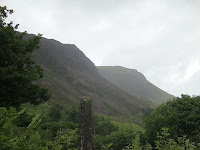 Greetings All,
Greetings All,Part of the reason for our trip to the North East and in particular the Newcastle area was for Fred to be able to see if he could find the gravesite of Mowat relatives (Archibald & Jane). Some of the more recent Mowat family were born here in Wallsend which is now a suburb of Newcastle. We headed to Holy Cross Cemetery first and it was there that Fred met Malcolm Armstrong a caretaker of sorts who advised us that the records for the burial dates Fred was looking for were not held on site. He had an appointment but asked if we could stay for 1/2 hour and then he would assist us. Fred gave him the names and dates of death and he made a call to Preston Cemetery where the records for all the cemeteries in the Newcastle area are held for them to get the location of the gravesite. While we were waiting for a call back, he discovered that Holy Cross Cemetery was opened in 1919 and so we were looking in the wrong Wallsend Cemetery. As it was taking an inordinate amount of time to get a call back he said he would go and research the information himself and would meet us at Church Bank Cemetery at 2:30 as he had a funeral at 1:15 that he had to over see. We were quite impressed with Malcolm as we felt he was going out of his way to help us locate the gravesite.
Leaving the cemetery, we headed off to Seaton Delaval Hall. The estate had been owned by the Delaval family since the time of the Norman Conquest. Admiral Delaval bought the estate from a poor relative and hired architect John Vanburgh in 1718 to modernize the existing mansion. However, Vanburgh did not think anything could be done so the place was demolished and a new Hall was built. The work was completed in 1728 two years after the Admirals death. The estate was then inherited by his nephew, Francis. Francis and his family moved in right away. The picture at the top is of the back entrance to the hall and the one on the left is what remains of the great hall with it's statues in the alcoves looking down on the floor. In1822 the centre hall was gutted by a fire that started in the east wing fire place. It is thought that the fire was started as a result of birds nesting in the chimney. The house was partially restored in 1862-63 but remains a shell inside.
The house remained vacant until 1980 when Edward Delaval Henry Astley, 22nd Baron of Hastings moved into the west wing and lived there until his death in 2000. The picture on the right is of a staircase that goes from the basement right to the top. We found it very interesting that the only support for the heavy stone stairs was the wall into which it was imbedded. We walked around the formal gardens before heading back to Wallsend and the Church Bank Cemetery
The picture on the left is of the entrance to the cemetery. The small white arch beside the church was used to hold a coffin while waiting for the service in the church. While waiting for Malcolm to arrive we wandered around the cemetery to see if we could locate the graves of Archibald or Jane Mowat, Fred's 2x great grandparents on the Mowatt side. Malcolm arrived with plans for the cemetery and a wooden stake that he has written Archie's name and gravesite number and a mallet. It turned out Archibald was buried in an unpurchased grave, that is, a paupers grave so there was no memorial marker.
Malcolm located the gravesite and hammered the stick he brought with him to mark the location of Archibald's grave so Fred could take a picture. He was unable to locate any record for the burial of Jane Mowat. Malcolm spent a good 45 minutes with us and I learnt an amazing amount of information about the burial practices of the past. For example, unless a cemetery is church specific most cemeteries are divided in two for the most part; Catholic and Protestant with a clear dividing line and other areas with specific designations. In the past couples of mixed religions couldn't be buried together, although restrictions are now being lessened. Rules governing areas of cemeteries designated Jewish are even stricter; for example, memorial stones in Hebrew, male name first regardless as to whether the spouse died first and no adornments allowed. I also learnt that green patches between memorial stones does not mean it is an available burial site. These areas would be graves that are unpurchased without memorial markers or better known to us as pauper graves. Up to 4 people could be buried in one such grave. Archibald we learnt was buried with 3 other people. Malcolm was also mystified that he could not find anything on Jane Mowat, Archie's wife. He offered Fred his assistance should Fred come across any further details about Jane.
It has been an enjoyable and educational day. We headed back to the hotel (Mercure George Washington Golf and Country) and relaxed on the patio by the 10th tee enjoying a pint before having supper at the hotel's restaurant.
Ta Ra,
Sandy & Fred



























